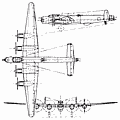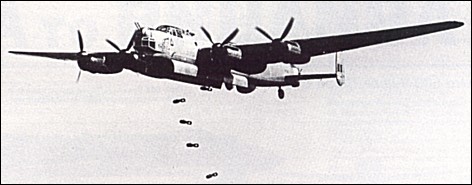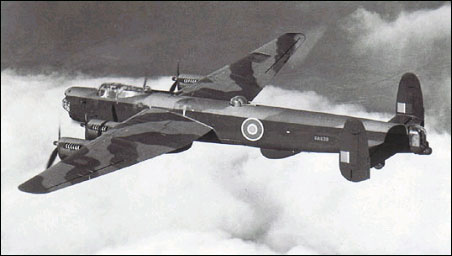|
| The last piston-engined bomber to serve with the RAF, the Lincoln conformed to Specification B.14/43 and was virtually a scaled-up version of the Lancaster. Indeed, the first version of the Lincoln was originally known as the Lancaster Mk IV. The first prototype flew on 9 June 1944.
Normally powered by four Rolls-Royce Merlin 85 engines with annular radiators, the Lincoln was armed with twin 12.7mm Browning machine-guns in a Boulton-Paul Type F nose turret; two 20mm Hispano Mk 4 or Mk 5 cannon in a Bristol B-17 Mk II dorsal turret; twin 12.7mm machine-guns in a Boulton Paul Type D rear turret and up to 6,350kg of bombs.
Intended for use in the Pacific theatre of war, the Lincoln appeared just too late to go into operational service, but instead became the RAF's standard post-war heavy bomber. Avro built 168 production aircraft, supplemented by 79 from Metropolitan-Vickers and 281 from Armstrong Whitworth. Six were also built in Canada and 54 with nose extensions in Australia by the Government Aircraft Factory at Fishermen's Bend, NSW. Thirty Lincolns were also diverted to the Argentine Air Force. Several versions of the bomber were produced during the production runs: Lincoln B.I with Merlin 85 engines; B.2 with Merlin 68A engines; Lincoln Mk 3 intended to be the ASR version but became the Shackleton; Lincoln B.4 with Merlin 85; Lincoln B.15 built in Canada; and Lincoln B.30 Australian version with Merlin 85 or 102 engines.
First issued to the RAF in September 1945, the bomber eventually equipped 20 squadrons. No 97 Squadron and others were detached to Singapore in 1950 for anti-terrorist raids and to Kenya in 1954. One was converted for the bulk uplift of fuel oil and made 45 civil flights during the Berlin Airlift.
| MODEL | "Lincoln" |
| CREW | 7 |
| ENGINE | 4 x Rolls-Royce "Merlin 85", 1305kW |
| WEIGHTS |
| Take-off weight | 34020 kg | 75002 lb |
| Empty weight | 19690 kg | 43409 lb |
| DIMENSIONS |
| Wingspan | 36.58 m | 120 ft 0 in |
| Length | 23.86 m | 78 ft 3 in |
| Height | 5.27 m | 17 ft 3 in |
| Wing area | 132.01 m2 | 1420.94 sq ft |
| PERFORMANCE |
| Max. speed | 475 km/h | 295 mph |
| Cruise speed | 345 km/h | 214 mph |
| Range w/max payload | 2366 km | 1470 miles |
| ARMAMENT | 6 x 12.7mm machine-guns, 6350kg of bombs |
 | A three-view drawing (690 x 688) |
| John Magee, e-mail, 18.05.2021 09:20 I served on the Lincolns at Manby as an engine mechanic in 1957-5, before being posted to Gibralter. reply | | Bert, 26.05.2020 19:35 There's one on display at the RAF Museum Cosford reply | | Peter Buchan, e-mail, 05.11.2016 19:51 Simon & Judith hi, my uncle was on Lincoln RF569 when it crashed on 2 /7 /1948 at Boscombe Down. Would've interested to ompare notes reply | | John West, e-mail, 13.05.2015 12:46 Re. my comment on5rth May 2015,are there any air gunners out there from83 Sqdn. in the 1950s?
Notice my name correction-West reply | |
| | John Westin, e-mail, 10.05.2015 01:47 During National Service as an Air Gunner I flew 600+ hours in Lincolns.I have my logbook recording the flight purposes reply | | Frank Hodges, e-mail, 06.05.2015 17:37 I was in signals RAF Upwood 1952 /54 - a National Service SAC. I asked for a flight having never been off the ground before and did a night flight in a Lincoln - most of it in the bomb aimer's seat. Highlight was a dummy bomb run over the White City stadium. I'm 81 now and still remember clearly going up the ladder and into the "front" seat for take off. Cold and noisy but SO exciting!! reply | | Martyn Markland, e-mail, 26.04.2015 22:54 My late father Keith Markland was a flight engineer on Lancasters who was transferred to Boscombe Down in 1943 /1944 to help in the early development of the new Lincoln bomber. He told me that when he arrived at Boscombe Down they had two prototypes to work on namely, the "P1" and "P2". The two flight crews were tasked with 150 hours of non-destructive testing of the aircraft under the supervision of Rolls Royce engineers. Apparently they flew the aircraft around the British Isles replacing and repairing parts as and when they failed. They changed propellers and were sometimes grounded due to cracks appearing in engine mountings etc. My father said that when news came in that the A-bombs had been dropped in Japan, the crews celebrated in grand style. Their greatest fear was having to be deployed to the Far East, being shot down and captured by the Japanese. If anyone has any further information about those early prototyping days it would be good hear from you. reply | | Tom Ainsby, e-mail, 25.04.2015 01:13 The Southend Lincoln was last seen in very large pieces at RAF Biggin Hill reply | | Simon Bacon, e-mail, 11.11.2014 22:03 Hi Judith, My grandfather was also killed in Lincoln RF560 on 2nd July 1948 at Boscombe Down A&AEE. My mother was only 7 at the time and knows very little about it and my grandmother passed away before it occurred to me to find out what she knew. Like you I am now trying to find out what I can, perhaps we can compare notes sometime? reply | | Judith Day, e-mail, 20.10.2014 22:35 My father was killed in R.F.Lincoln 560 on 2nd July 1948 at Boscombe Down A&AEE. He always told his family that they were actually testing jet engines. The accident record from the time states that the engines were Merlin 86. I can find no record of this type of Merlin engine. Can anybody shed any light on this? Many thanks from our family. reply | | Barry flewitt, e-mail, 08.08.2014 23:42 I seem to remember one of these being at a Museum at Southend Essex Airfield. There was also a Blackburn Beverly.
I wonder what became of them? reply | | RickyCooper, e-mail, 22.11.2013 03:32 Reference Johnashmr [22.08.2011]
I also remembered the Lincoln shot down by the Russians for flying into their "Air Space" during a Training Flight.
I thought at the time that no "Civvy" would believe me - so I kept the Report of the incident [which I still have].
The next attack took place at RAF Shawbury - where the "enemy" destroyed an H2S Radar Dome. The only clue to the identity of the perpetrators was a bunch of black feathers.
! reply |
| Sam Colley, e-mail, 17.05.2013 11:51 I served my national service from 1951 to 1953 at Martlesham Heath as a Junior Technician (Navigation). The station included a Bomb Ballistics Experimental Unit and, among the aircraft used for bombing trials was a Lincoln. This had been modified with two Rolls Royce Avon jets replacing the inboard Merlins. I guess this was useful to give the Lincoln a higher altitude capability for bombing trials. The bomb bay had also been modified, the doors being cut away to allow it to carry an enormous bomb which protruded well outside the bottom of the aircraft. I had nothing to do with the bombing trials, but was responsible for checking and maintaining the navigation instruments on the aircraft (including the bomb sight and autopilot.)I did get a flight in the Lincoln, which I remember as being very noisy, but gave me great pleasure. reply | | Roland L. Jillings, e-mail, 09.05.2013 23:34 I was one of a small group sent to Yeovilton Nave Air station in 1955 to repair a Lincoln. It was run into a hanger wall when a Navy pilot moved it. It had been used as a pretend target for the Navy to find during night flights. We maesured the wing distortion and found one wing was 9 inches pushed back It still flew however. reply | |
| | Norrie Rafferty (Jock), e-mail, 17.04.2013 00:34 I was an Engine Fitter on Lincolns at RAF Watton DEV "B" 1960 /1961. Keith Rielly and Patrick o Sullivan were the two guys I remember.The Lincolns were engaged in dropping "Window" around the Norfolk area. reply |
| Terry Busby, e-mail, 20.03.2013 12:21 OH! There are so many times when one misses one's
memory. my name is Terry Busby and I served Mational
Service at Scampton as Inst.Tech.1952. I do wish that
I could remember the names of the lads in the Section.
We worked on ' North Flight for a long time . Three of
the names that come to mind are - Harry Potter(a textile
engraver by trade from Salford ) (Gordon Fuller ,worked
at AP.Frods. (Appleby Froddingham Steel Works ) and
( Mollineaux from Wolverhampton - as well as Sgt. Cooksey
in charge a lovely fellow in fact they all were . We
transferred with our Lincolns to RAF " Lindholme about
the end of 1952 . Does anyone come from that era and place ? reply |
| David Boothby, e-mail, 08.02.2013 19:34 A comment for Ken Clark really. My Father, George Boothby served at Scampton 1950-52 during his National Service. I remember every time we drove past Scampton Church, he would stop and go visit the 4 graves from RA692. From what he told me, he knew the crew of that Aircraft, having been a rigger on the Groundcrew for that Sqn (230OCU?). Unfortunately, he passed away in 2005 and a lot of knowledge of that era went with him. Like father like son, I followed him into the RAF, serving 22years. I was at Scampton Churchyard only yesterday and can confirm that everything is still kept in beautiful condition, with the first snowdrops starting to show.
Regards David. reply |
| John Norman, e-mail, 12.12.2012 21:30 I was stationed at RAF Wyton from late 1947 to early 1949 as an Air Radar Mechanic when a few of us were sent as observers on practise bombing runs to Heligoland. There had been reports by aircrew of radar failures which could never be confirmed on the ground later, & we were supposed to keep an eye on how the various radar systems were operated. Any who has been near the cockpit of a bomber in flight should have known how impractical it was to wander around looking over the shoulders of crews, in fact none of us had anything to report. The attempt was repeated after our presence was properly explained to the aircrew & we were belatedly shown where the escape hatch was. I did not take part because I grabbed my 'chute by the wrong handle while climbing in & opened it on the ground. reply | | John Beavin, e-mail, 25.10.2012 04:28 I was a member of the ATC, and on September the 8th 1946 I had an hours flight in OL E of 83 sqdn at Coningsby, a big change from the Lancasters we were used to flying in from East Kirkby. reply |
| Terry Busby, e-mail, 11.09.2012 22:09 I have just submitted a comment, and it has now
started me thinking hard of any names I may be
able to remember - it will probably now be on
my mind for ever more ! I remember the Station
commander being called Johnson and our NCO in charge
of section being Sgt. Cooksey , that is all but I
hope someone is still on this earth who was also
there at that time . reply |
|
Do you have any comments?
|
| 
COMPANY
PROFILE
All the World's Rotorcraft
|



 Terry Busby
Terry Busby David Boothby
David Boothby Ann Fitzgerald
Ann Fitzgerald





20
reply